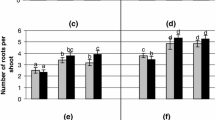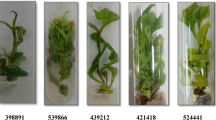Abstract
Solanum nigrum Linn., known for hepatoprotective and antioxidant properties, is extensively harvested from the wild. Supply is far short of demand, necessitating requirement of efficient in vitro propagation protocols. Nodal explants from wild S. nigrum plants were cultured in vitro in MS medium supplemented with 3.0 mg L−1 IAA, 0.5 mg L−1 BAP and gelled with 0.8 % agar. After 30 days, shoots buds were transferred to liquid MS medium of same composition. Subsequent subculture was carried out every 6 days. Shoot doubling time in solid and liquid media was calculated. Total phenolics, proanthocyanidin and flavonoid contents, ABTS.+ and hydrogen peroxide radical scavenging antioxidant capacity of wild and in vitro aqueous leaf extracts were estimated and compared. In MS agar, 18 shoot buds were produced per explant after 30 days of culture, with shoot doubling time of 7.11 days. In liquid media, 21 shoots per explant were produced in 6 days, with a 5-fold higher multiplication rate and shoot doubling time of 1.37 days. Leaves were morphologically similar to those of wild plants. Total phenolics, proanthocyanidin and flavonoid contents of in vitro leaf extracts was 5–10 times higher than that of wild plants while ABTS.+ and H2O2 radical scavenging activity was similar in both extracts. Liquid media is better suited for in vitro propagation of S. nigrum since enhanced multiplication rate was observed with shorter subculture intervals. Moreover, plants retained normal morphology and antioxidant property.

Similar content being viewed by others
References
Adelberg J (2006) Agitated, thin-films of liquid media for efficient micropropagation. In: Dutta S, Gupta SD, Ibaraki (eds) Plant tissue culture engineering. Springer, Dordrecht, pp 101–117
Aiyegoro OA, Okoh AI (2009) Phytochemical screening and polyphenolic antioxidant activity of aqueous crude leaf extract of Helichrysum pedunculatum. Int J Mol Sci 10:4990–5001
Apóstolo NM, Llorente BE (2000) Anatomy of normal and hyperhydric leaves and shoots of in vitro grown Simmondsia chinensis (link) Schn. In vitro Cell Dev Biol Plant 36:243–249
Bhat MA, Ahmad S, Aslam J, Mujib A, Mahmooduzzfar A (2008) Salinity stress enhances production of solasodine in Solanum nigrum L. Chem Pharm Bull 56(1):17–21
Bhat MA, Mujib A, Junaid A, Mohamooduafar M (2010) In vitro regeneration of Solanum nigrum with enhanced solasodine production. Biol Plant 54:757–760
Cai Y, Luo Q, Sun M, Corke H (2004) Antioxidant activity and phenolic compounds of 112 traditional Chinese medicinal plants associated with anticancer. Life Sci 74:2157–2184
Chen J, Ziv M (2004) Ancymidol-enhanced hyperhydric malformation in relation to gibberellin and oxidative stress in liquid-cultured Narcissus leaves. Vitro Cell Dev Biol- Plant 40(6):613–616
Cui X-H, Chakrabarty D, Lee E-J, Paek K-Y (2010) Production of adventitious roots and secondary metabolite by Hypericum perforatum L. in a bioreactor. Biosource Techn 101:4708–4716
de Oliveira AC, Valentim IB, Silva CA, Bechara EJH, de Barros MP, Mano CM, Goulart MOF (2009) Total phenolic content and free radical scavenging activities of methanolic extract powders of tropical fruit residues. Food Chem 115:469–475
Flegmann AW, Wainwright H (1981) Shoot doubling time: a quantitative parameter for characterizing shoot cultures in vitro. Plant Cell Tissue Organ Cult. 1:85–92
Ganeshan S, Manoharan R, Muthukrishnan A, Murugaraj J, Gnanajothi KD, Annavi A, Markandan M, Manickam M, Natesan S, Andy G (2013) Effect of culture conditions, cytokinins, methyl jasmonate and salicylic acid on the biomass accumulation and production of withanolides in multiple shoot culture of Withania somnifera (L.) dunal using liquid culture. Acta Physiol Plant 35(3):715–728
George EF (1993) Plant propagation by tissue culture. In: Part 1-The technology. Edington: Exegetics limited. pp 337–356
Georgiev MI, Weber J, Maciuk A (2009) Bioprocessing of plant cell cultures for mass production of targeted compounds. Appl Microbiol Biotechnol 83:809–823
Gurel A (2009) Propagation possibilities of commercially important plants through tissue culture techniques. Int J Nat Eng Sci 3:07–09
Hassanein AM, Soltan DM (2000) Solanum nigrum is a model system in plant tissue and protoplast cultures. Biol Plant 43:501–509
Heo KS, Lim KT (2004) Antioxidative effects of glycoprotein isolated from Solanum nigrum L. J Med Food 7(3):349–357
Ivanova M, Van Staden J (2011) Influence of gelling agent and cytokinins on the control of hyperhydricity in Aloe polyphylla. Plant Cell Tiss Organ Cult 104:13–21
Jain R, Sharma S, Gupta S, Sarethy IP, Gabrani R (2011) Solanum nigrum: current perspectives on therapeutic properties. Altern Med Rev 16:78–85
Lin HM, Tseng HC, Wang CJ, Lin JJ, Lo CW, Chou FP (2008) Hepatoprotective effects of Solanum nigrum Linn extract against CCl(4)-induced oxidative damage in rats. Chem Biol Interact 171(3):283–293
Loganayaki N, Siddhuraju P, Manian S (2010) Antioxidant activity of two traditional Indian vegetables: solanum nigrum L. and Solanum torvum L. Food Sci Biotechnol 19:121–127
Murashige T, Skoog F (1962) A revised medium for rapid growth and bioassays with tobacco cultures. Physiol Plant 15:473–497
Pati PK, Kaur J, Singh P (2011) A liquid culture system for shoot proliferation and analysis of pharmaceutically active constituents of Catharanthus roseus (L.) G. Don Plant Cell Tiss Organ Cult 105:299–307
Prasanth Kumar V, Shashidharan S, Kumar MM, Sridhara BY (2001) Cytoprotective role of Solanum nigrum against gentamicin-induced kidney cell (Vero cells) damage in vitro. Fitoterapia 72(5):481–486
Re R, Pellegrini N, Proteggente A, Pannala A, Yang M, Rice-Evans C (1999) Antioxidant activity applying an improved ABTS radical cation decolorization assay. Free Radical Bio Med 26:1231–1237
Ruch RJ, Cheng SJ, Klaunig JE (1989) Prevention of cytotoxicity and inhibition of intercellular communication by antioxidant catechins isolated from Chinese green tea. Carcinogen 10:1003–1008
Savio LEB, Astarita LV, Santarem ER (2012) Secondary metabolism in micropropagated Hypericum perforatum L. grown in non-aerated liquid medium. Plant Cell Tiss Organ Cult 108(3):465–472
Steephen M, Nagarajan S, Doss G (2012) In vitro production of adventitious roots containing asiaticoside from leaf tissues of Centella asiatica L. In Vitro Cell Dev Biol Plant 48:200–207
Sun JS, Tsuang YW, Chen JJ, Huang WC, Hang YS, Lu FJ (1998) An ultra-weak chemiluminescence study on oxidative stress in rabbits following acute thermal injury. Burns 24:225–231
Swain SS, Tripathy T, Mohapatra PK, Chand PK (2010) Photosynthetic and transpiration responses of in vitro-regenerated Solanum nigrum L. Plants to ex vitro adaptation. In Vitro Cell DevBiol—Plant 46:134–141
Thring TSA, Hili P, Naughton DP (2009) Anti-collagenase, anti-elastase and anti-oxidant activities of extracts from 21 plants. BMC Complement Altern Med 9:27. doi:10.1186/1472-6882-9-27
Wu Z, Chen LJ, Long YJ (2009) Analysis of ultrastructure and reactive oxygen species of hyperhydric garlic (Allium sativum L.) shoots. In Vitro Cell Dev Biol Plant 45:483–490
Ziv M (2000) Bioreactor technology for plant micropropagation. In: Janick J (ed). Horticultural Reviews, 24th edn. John Wiley & Sons Inc., p 24
Acknowledgments
The authors thank Jaypee Institute of Information Technology, NOIDA, for providing infrastructure facilities for carrying out the work.
Conflict of interest
The authors also declare that they have no conflict of interest.
Author information
Authors and Affiliations
Corresponding author
Additional information
Communicated by J. van Staden.
Rights and permissions
About this article
Cite this article
Sarethy, I.P., Kashyap, A., Bahal, U. et al. Study of liquid culture system for micropropagation of the medicinal plant Solanum nigrum L. and its effect on antioxidant property. Acta Physiol Plant 36, 2863–2870 (2014). https://doi.org/10.1007/s11738-014-1655-0
Received:
Revised:
Accepted:
Published:
Issue Date:
DOI: https://doi.org/10.1007/s11738-014-1655-0




